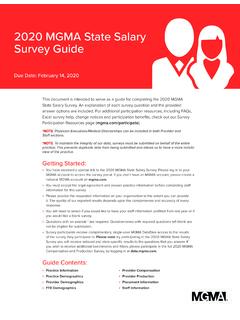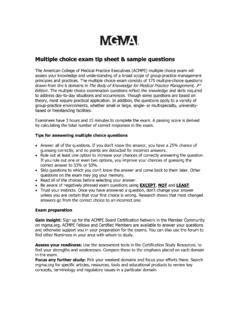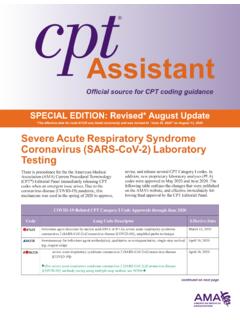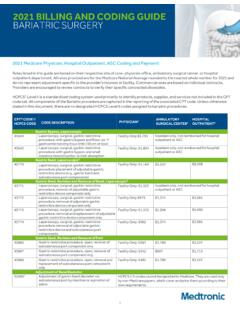Transcription of MGMA COVID-19 Coding Cheat Sheet ICD-10-CM CODES
1 mgma COVID-19 Coding Cheat Sheet (Updated Dec. 23, 2020) ICD-10-CM CODES CONFIRMED COVID-19 DIAGNOSIS Code only confirmed cases Code only a confirmed diagnosis of the 2019 novel coronavirus disease ( COVID-19 ) as documented by the provider, documentation of a positive COVID-19 test result, or a presumptive positive COVID-19 test result. For a confirmed diagnosis, assign code , COVID-19 . This is an exception to the hospital inpatient guideline Section II, H. In this context, confirmation does not require documentation of the type of test performed; the provider s documentation that the individual has COVID-19 is sufficient. ICD-10-CM code , COVID-19 , may be used for discharges/date of service on or after April 1, 2020.
2 For guidance prior to April 1, 2020, please refer to the supplement to the ICD-10-CM Official Guidelines for Coding encounters related to the COVID-19 coronavirus outbreak. Sequencing of CODES : When COVID-19 meets the definition of principal or first-listed diagnosis, code , COVID-19 , should be sequenced first, and followed by the appropriate CODES for associated manifestations, except in the case of obstetrics patients. Use as principal diagnosis followed by COVID-19 PNEUMONIA Code first COVID-19 ( ) Pneumonia due to coronavirus disease 2019 BRONCHITIS For a patient with acute bronchitis confirmed as due to COVID-19 , assign code Bronchitis not otherwise specified (NOS) due to the COVID-19 should be coded using code J40, Bronchitis, not specified as acute or chronic.
3 Acute bronchitis due to other specified organism Bronchitis, not specified as acute or chronic J40 LOWER RESPIRATORY INFECTION If the COVID-19 is documented as being associated with a lower respiratory infection, not otherwise specified (NOS), or an acute respiratory infection, NOS, this should be assigned with code J22, Unspecified acute lower respiratory infection. If the COVID-19 is documented as being associated with a respiratory infection, NOS, it would be Unspecified acute lower respiratory infection J22 Other specified respiratory disorders mgma COVID-19 Coding Cheat Sheet (Updated Dec. 23, 2020) appropriate to assign code , Other specified respiratory disorders.
4 ACUTE RESPIRATORY DISTRESS SYNDROME (ARDS) Acute respiratory distress syndrome (ARDS) may develop in with the COVID-19 , according to the Interim Clinical Guidance for Management of Patients with Confirmed 2019 Novel coronavirus ( COVID-19 ) Infection. Cases with ARDS due to COVID-19 should be assigned the CODES J80, Acute respiratory distress syndrome. Acute respiratory distress syndrome J80 SIGNS AND SYMPTOMS For patients presenting with any signs/symptoms (such as fever, etc.) and where a definitive diagnosis has not been established, assign the appropriate code(s) for each of the presenting signs and symptoms. Cough R05 Shortness of breath Fever, unspecified EXPOSURE TO COVID-19 For cases where there is a concern about a possible exposure to COVID-19 , but this is ruled out after evaluation, it would be appropriate to assign the code , Encounter for observation for suspected exposure to other biological agents ruled out.
5 For cases where there is an actual exposure to someone who is confirmed to have COVID-19 , it would be appropriate to assign the code , Contact with and (suspected) exposure to COVID-19 . Encounter for observation for suspected exposure to other biological agents ruled out Contact with and (suspected) exposure to COVID-19 Encounter for screening for COVID-19 (for asymptomatic individuals being screened for COVID-19 , have no known exposure to the virus, and test results are either unknown or negative) IMPORTANT NOTES Sequencing: should be the primary diagnosis in confirmed COVID-19 diagnosis, followed by appropriate CODES for associated manifestations: (other viral pneumonia) (acute bronchitis due to other specified organisms) J22 (unspecified acute lower respiratory infection NOS) J40 (bronchitis, not specified as acute or chronic) J80 (acute respiratory distress syndrome) (other specified respiratory disorders) Diagnosis code , coronavirus infection, unspecified, would in generally not be appropriate for the COVID-19 , because the cases have universally been respiratory in nature, so the site would not be unspecified.
6 If the provider documents suspected , possible or probable COVID-19 , do not assign code Assign a code(s) explaining the reason for encounter (such as fever, or ). For more detailed guidance regarding diagnosis Coding for COVID-19 and guidelines for pregnant patients, see this CDC guideline. mgma COVID-19 Coding Cheat Sheet (Updated Dec. 23, 2020) CPT CODES TESTING These CODES are used to report a qualitative or semi-quantitative immunoassay to identify infectious agent antibodies (DNA or RNA); SARS-CoV-2. Specimen is serum which a reagent strip is used for the specific antibody. Immunoassay for infectious agent antibody, quantitative, not otherwise specified 86317 Immunoassay for infectious agent antibody(ies), qualitative or semiquantitative, single-step method (eg, reagent strip) 86318 Neutralizing antibody, severe acute respiratory syndrome coronavirus 2 (SARS-CoV-2) ( coronavirus disease [ COVID-19 ]); screen 86408 The CPT Editorial Panel published the following two CODES , effective August 10, 2020, for reporting lab tests that determine if the antibodies present can block COVID-19 viral infection.
7 Neutralizing antibody, severe acute respiratory syndrome coronavirus 2 (SARS-CoV-2) ( coronavirus disease [COVID19]); titer 86409 Immunoassay for infectious agent antibody(ies), qualitative or semiquantitative, single step method (eg, reagent strip); severe acute respiratory syndrome coronavirus 2 (SARS-CoV-2) ( coronavirus disease [ COVID-19 ]) 86328 ANTIBODY TESTING: These two new CODES are effective immediately, according to the AMA. The new CODES are intended for use as the industry standard for accurate reporting and tracking of blood tests performed to specifically detect antibodies associated with the SARS-CoV-2 virus, according to the AMA release. CPT 86328 is for antibody tests using a single-step method immunoassay.
8 This often includes a strip with all the critical components for the assay, and is appropriate for a point of care platform, according to an AMA press release. CPT 86769 is for antibody tests employing a multiple-step method. Severe acute respiratory syndrome coronavirus 2 (SARS-CoV-2) ( coronavirus disease [ COVID-19 ]) antibody, quantitative 86413 Antibody; severe acute respiratory syndrome coronavirus 2 (SARS-CoV-2) ( coronavirus disease [ COVID-19 ]) 86769 Infectious agent antigen detection by immunoassay technique, (eg, enzyme immunoassay [EIA], enzyme-linked immunosorbent assay [ELISA], fluorescence immunoassay [FIA], immunochemiluminometric assay [IMCA]) qualitative or semiquantitative; adenovirus enteric types 40/41 87301 Effective June 25, 2020, code 87426 is used to report infectious agent antigen detection of SARS-CoV and SARS-CoV-2 by immunoassay technique.
9 It is a waived test under CLIA. severe acute respiratory syndrome coronavirus (eg, SARS-CoV, SARS-CoV-2 [ COVID-19 ]) 87426 mgma COVID-19 Coding Cheat Sheet (Updated Dec. 23, 2020) severe acute respiratory syndrome coronavirus (eg, SARS-CoV, SARS-CoV-2 [ COVID-19 ]) and influenza virus types A and B 87428 Infectious agent detection by nucleic acid (DNA or RNA); respiratory virus (eg, adenovirus, influenza virus, coronavirus , metapneumovirus, parainfluenza virus, respiratory syncytial virus, rhinovirus), includes multiplex reverse transcription, when performed, and multiplex amplified probe technique, multiple types or subtypes, 3-5 targets. 87631 Effective October 6, 2020, code 87631 is revised to reflect a test panel of multiple viruses.
10 The revision captures 3-5 targets by DNA or RNA agent detection resulting in viral panel to distinguish: Influenza A Influenza B RSV SARS-CoV-2 AMA provided this guidance in a CPT assistant Special Edition: October Update Infectious agent detection by nucleic acid (DNA or RNA); severe acute respiratory syndrome coronavirus 2 (SARS-CoV-2) ( coronavirus disease [ COVID-19 ]), amplified probe technique. 87635 The AMA has published guidance in CPT assistant stating to use 87635. All healthcare entities must manually load it into their EHRs. An excerpt from CPT assistant is as follows: These CODES are effective immediately for use in reporting this testing service. Note that code 87635 is not in the CPT 2020 publication; however, it will be included in the CPT 2021 code set in the Microbiology subsection of the Pathology and Laboratory section.







